Virtual reality is the kind of out there hard-to-fathom technology that takes real effort and (sometimes) a stiff drink to describe effectively.
However with CES 2016 now in full swing it has become clear that virtual reality's time is now, and that 2016 is the year when it all starts to work.
We all have these emotional vices, for some it's sport, others history. For as long as we can remember technology and space have been ours.
Nothing made us happier than sharing the uncontrollable grin that spread across our faces when we stepped into the twisted world of 'Rapture' in Bioshock, or the jaw-dropping beauty of Mars' Southern Lights, never seen before until just a few months ago. If we can in some small way plant that seed of excitement in just one other person, then we'll have felt like we've done our job.
Virtual reality is one of these moments, and it's uniquely special because it has taken a very long time to get here.
Damaged by our desperation to have it 'here and now', virtual reality has been dragged kicking and screaming through 20 years of technological progress, constantly suffering from being just on the outer fringes of possible.
In its various forms it has been bulky, uncomfortable, laggy and almost always expensive.
There are some technologies that we've always felt we 'deserved'. (Interestingly the smartphone wasn't one of them - it wasn't until Apple produced the iPhone that we suddenly knew we wanted phones without buttons that could take pictures of our own faces.) Virtual reality is one of those, and that's because it's tied to one of human nature's most basic instincts: curiosity.
Virtual reality is a gateway for exploration, it gives us the chance to explore fictional worlds, create three-dimensional masterpieces and travel to far-flung locations on our own planet - all without leaving our living room. It's the classic sell that has so often been thrown with enthusiasm down our throats only to be disappointingly spat back out again when it turns out the worlds are giant polygons and that masterpiece looks more like a three-year-old's breakfast.
'Don't Panic' ' as one of fiction's most underrated books once said ' because we're here to tell you that we've travelled to fictional worlds made out of nothing but imagination, we've created a giant glowing castle and we've sat on the beach of a Pacific Island as the sun set. It is finally ready.
So how are you going to accomplish these feats? Well leading the charge are three very different products that will at their core offer three very different experiences.
Oculus Rift - The One That Started It All
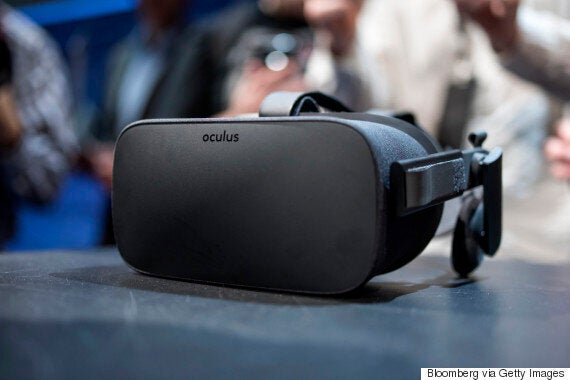
When Oculus founder Palmer Luckey created the first Rift headset it was nothing more than a shambolic collection of tape and glass. The young hopeful was finishing a jigsaw puzzle with the end result being virtual reality.
So many true innovations start this way, you have the finished picture in your head and you're left searching for all the right pieces. Thankfully for Luckey Moore's law was now moving at such a pace that his jigsaw was being finished for him.
Screens got better, optics became cheaper and sensors shrunk at breakneck speed until just two years later he was able to produce something that could trick the mind into thinking it was somewhere it wasn't.
When we fist used Oculus Rift it felt, we'll be honest, like a disappointment. The screen was crushingly poor, the optics were such that even the slightest movement meant we were temporarily trapped in a fuzzy world. Think how perfectly aligned your eyes have to be for a pair of binoculars and you'll get the idea. It was prohibitively difficult.
Things have moved very quickly since then, after being bought by Facebook the company has attained a financial stability that it needed considering it hasn't actually released a product yet.
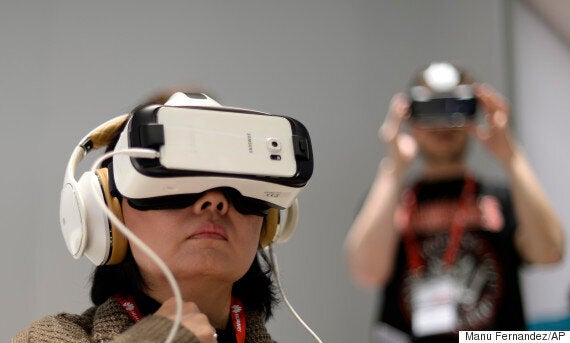
The partnership with Samsung has been crucial, it has shown Oculus as more than just a headset but a brand. You see that logo and you know your smartphone won't let you down.
PlayStation VR - Fun For All The Family
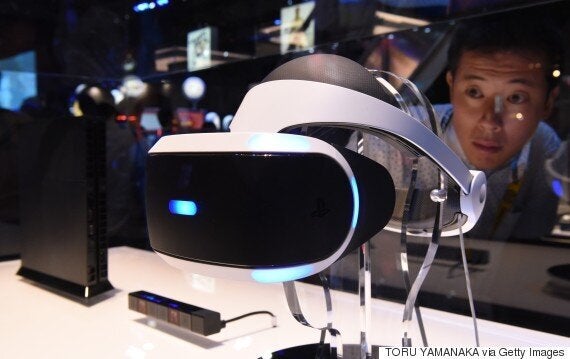
If there's one company that has been actively pushing virtual reality in a big way it's Sony. Never afraid to push the boundaries of what's commercially sensible Sony's forward thinking approach has cost it dearly, but the result has ultimately been Project Morpheus.
PlayStation VR is the result of using us as guinea pigs. Releasing physical products that we could go out and buy, of course they weren't ever packaged as virtual reality. Instead they were neatly released as different pieces of the jigsaw puzzle.

The Sony Personal Viewer was a '£1000 toy for the ultra-rich - a headset capable of creating a virtually IMAX-sized 3D screen it was the closest thing we ever came to feeling 'immersed' pre-Morpheus. A piece of the puzzle.
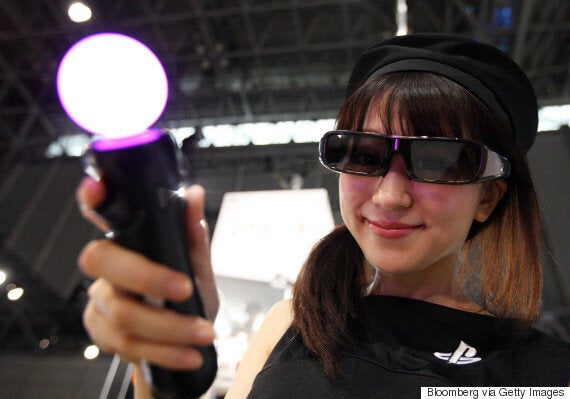
PlayStation Move brought motion control to Sony's flagship games console. Looking like two glowing microphones it was impressively precise and depressingly underused. Combined with the PlayStation Eye camera it allowed you to be tracked within a virtual space in front of your TV. Another piece of the puzzle.
Combine them and you have Morpheus. A virtual reality headset with full-body motion tracking and precise controllers that allow you to physically wield objects within a virtual environment.
To use it is to feel truly liberated because while Oculus allows you to look around this fantastical world, Morpheus allows you to reach out and touch it.
HTC Vive Pre- The Last Piece
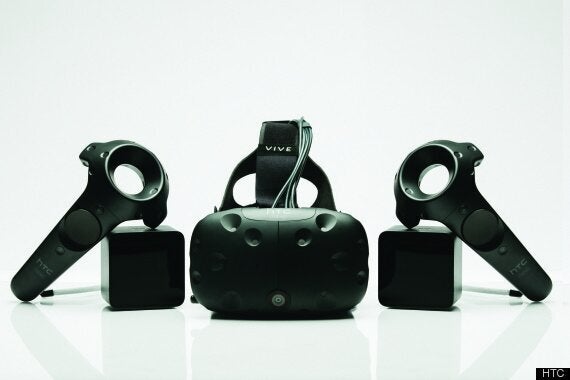
Originally announced at the smartphone conference Mobile World Congress in Barcelona, Vive was a shock.
If you're not familiar with HTC's 2015 financial status (because why would you) then we'll give you a heads-up: it has been a tough few years.
Releasing always-excellent yet sometimes unimaginative smartphones HTC sat for too long on its laurels of success, evolving into a company that had bloated ranges of smartphones all impossible to remember and almost all identical.
Desperately in need of a shake up it changed its tune, ditched almost all its product lines and focused on a single range of phones that you could count on one hand. It worked.
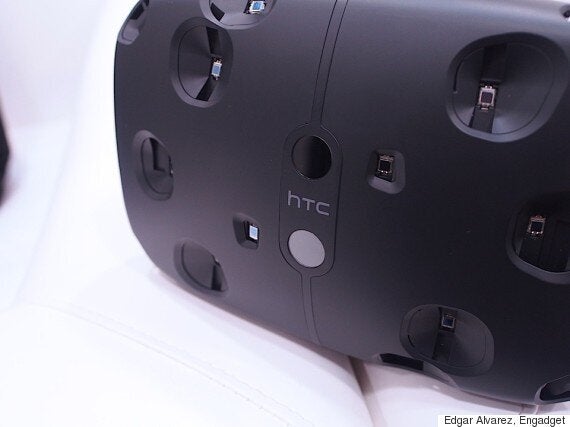
To look at, the first iteration of Vive bore a striking resemblance to a fighter pilot's helmet and there's a reason for that. The tiny dimples all over are tracking sensors, the very same sensors that fighter pilots actually use for their own headsets allowing them to 'see through' their planes thanks to a network of cameras on the hull and some astonishing visual wizardry.
It's this motion tracking that sits at the very core of Vive's success. The fluidity with which it follows your every move is utterly unnoticeable creating the first part of the illusion.
The second part is awareness. Vive is the first and only virtual reality headset that from the outset allows you to walk around. It maps the room creating a 'holodeck' that you can then freely explore.
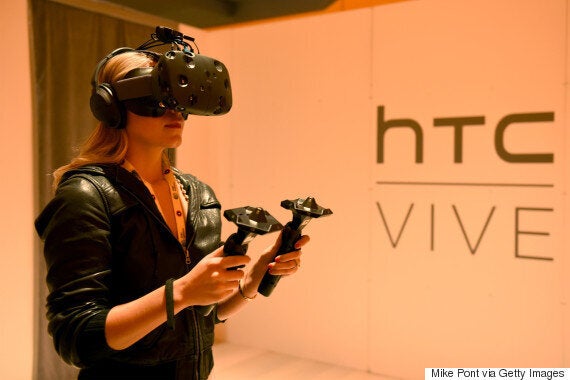
It is this acknowledgement that you are entering a 'virtual' place that bizarrely cements your immersion. It sets realistic boundaries giving your brain something to anchor to so that when the program does load, you're all the more impressed when your brain promptly throws those boundaries out of the window.
Put the headset on and you're greeted with a utopian landscape of white polygonal pillars that gently rise and fall. Think of this as the Construct from 'The Matrix', it's the loading screen, except that it's an actual room.
Pixels are forgotten - computing power has now reached the stage at which you're no longer squinting to make out small details.
The calming voice of the operator comes over the headphones announcing that she's about to launch the first program. With the tone of someone that's seen this a hundred times before she politely suggests that I might want to loosen my knees as 'the first time can come as a bit of a shock.'
She's not wrong.
The whiteness fades into absolute black and then suddenly a deep and never-ending blue appears. We freeze, assessing the image in front of us. We move, and suddenly everything changes.
It's the difference between picture and video, between touching and then seeing. We move our head down and feel an overwhelming sense of vertigo, the reason for which is that we're stood on the edge of a giant ship, and it's at the bottom of the ocean.

We move our head, look around. The operator's voice appears in the background and gently suggests that we might move. Move? Of course, move. We move slowly and nervously like someone who's just stood up after a drinking contest and is anxiously awaiting the inevitable failure of motor function. It doesn't come, and instead we realise that this really is it, we can actually walk.
The second worry then raises its ugly head: 'What if I walk into a wall?' The operator suggests that we actually try and do it, clearly knowing full well that something will protect me. We take a few tentative steps forward and continue to the hand rail of the ship, as we get closer a shimmering world starts appearing out of nowhere - it's the real-world, stunningly overlayed using a 14MP camera on the front of the headset.
It's called Chaperone and it's designed to do one simple task, which is put your mind at ease. Constantly running in the background it's a superhuman's view of the real-world, being mapped out using the camera and the sensors in tandem. Move back away from the obstacle and it gently fades away, sinking you back onto the deck of the ship.
The operator then warns me that the program will soon end, and sure enough after about 15 seconds pause we're pulled unwillingly from the ocean and into a black room that's split up with gridlines.
The operator hands us two controllers. Originally 3D printed, the new controllers are stunningly well finished. Wireless, light and easy to hold they felt remarkably precise despite their size. It wasn't long before they felt like an extension.
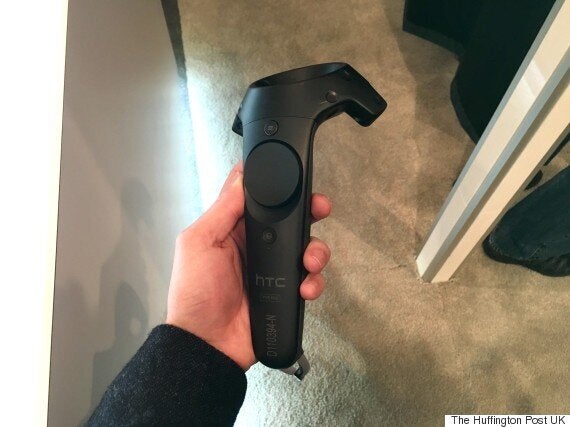
We're told that we can use them to draw. So we grab the pen and draw, producing a glowing green line that hangs suspended in space. We draw some more, producing a simplistic flower. The operator ' again smiling as she said it ' gently reminds us that we can walk around it. Of course. we move and walk around our creation, a hanging neon sign that can be erased, moved and moulded as I see fit. It's at this point that the realisation dawns on you: you can create literally anything; from a giant pyramid to a fully grown human being, all drawn in 3D space.
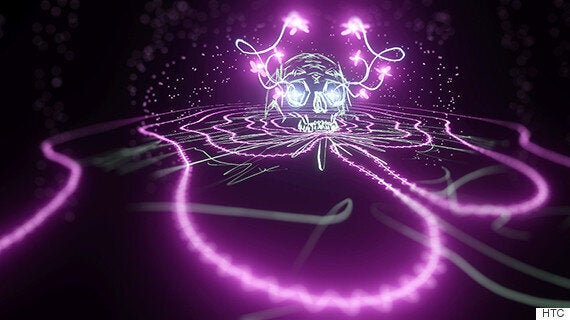
We wrack our brains feeling like a child who's just been asked to provide the answer to quantum theory and then suddenly a shape springs into my head: a castle.
We draw the door, then the front facing wall, as I walk around I then reach out and bring it into true existence by giving it depth. We add buttressing at the top and finally, because all castles should have this, a flag.
The now familiar voice of the operator appears again telling me the program is about to end and it's at this point we realise we don't want it to end. We're begrudgingly pulled out of the world once more and thrown into what looks like an experimental science lab.
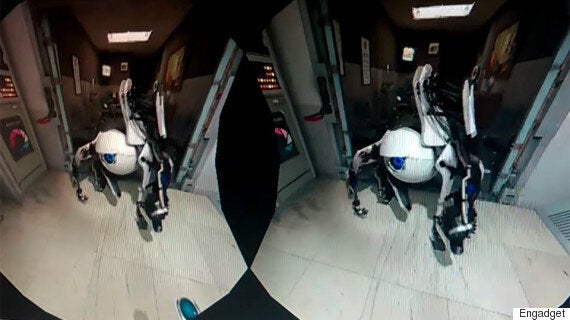
We're in the 'robotics maintenance' lab from the hit game Portal where a familiar voice instructs me to perform a number of tasks, sarcastically belittling me along the way. This room is all about the little details, from the drawers you have to open to the tools you'll pick up.
We're told we have to repair a faulty robot. Using my two controllers we pull it apart, exploding it into a hanging cutaway of every whirring, moving component. You can rotate them, pick them out and adjust them, interacting via a floating holographic display that acts as a screen.
The level of detail is astonishing, from the rust on the handles of the drawers to the background noise that comes from being inside a busy factory.
Inevitably we fail miserably in my task and am left starting at a useless pile of junk as the robot falls apart. My master notes that she's unsurprised by our failure and that instead the company has found a better use of my time. That time is 'Portal', and as prequels go, it's one that'll leave you grinning ear from ear.
The program ends, we're brought back to the blackness and then, bleary eyed and reluctantly we remove the headset.
The New World
Oculus Rift, Project Morpheus and Vive Pre have all shown us that virtual reality is finally ready for mass consumption, that much is hard to argue with.
If it has one last hurdle then that is the simple fact that not everyone on the planet has a gaming PC.
It's a demanding piece of technology, it needs brute power to process all those pixels and while Oculus and Samsung have shown that VR works on the go, if you want to start exploring the deck of a sunken ship you're going to need a tank of a computer.
HTC isn't worried though, and frankly neither should we. HTC's vr team explained to me that they're so confident in Moore's law they believe that by halfway through 2016 PC's will be powerful and cheap enough to run Vive.
Sony's tackled PlayStation VR by including an extra processing unit that takes on the responsibility of the extra grunt.
What excites me the most however is not what we've seen already, but what I'm yet to see. Virtual reality isn't the exclusive servant of mass entertainment, it's a gateway into a thousand different scenarios.
Imagine the benefits this new virtual environment could have on learning. Imagine children no longer having to slave through hours of maths, but instead seeing maths in action, interacting with it by building a giant pyramid of blocks.
Learning about the solar system would become a journey to the surface of other planets allowing children to physically walk around the surface of Mars, or look up and see the aurora of an alien planet.
While it's positive to know that initiatives like Google Cardboard are to some extent broadening the reach of virtual reality to the younger and older generation, the fact is that Moore's Law is so busy proving itself right that it won't be long before all of us will be getting the full experience.
